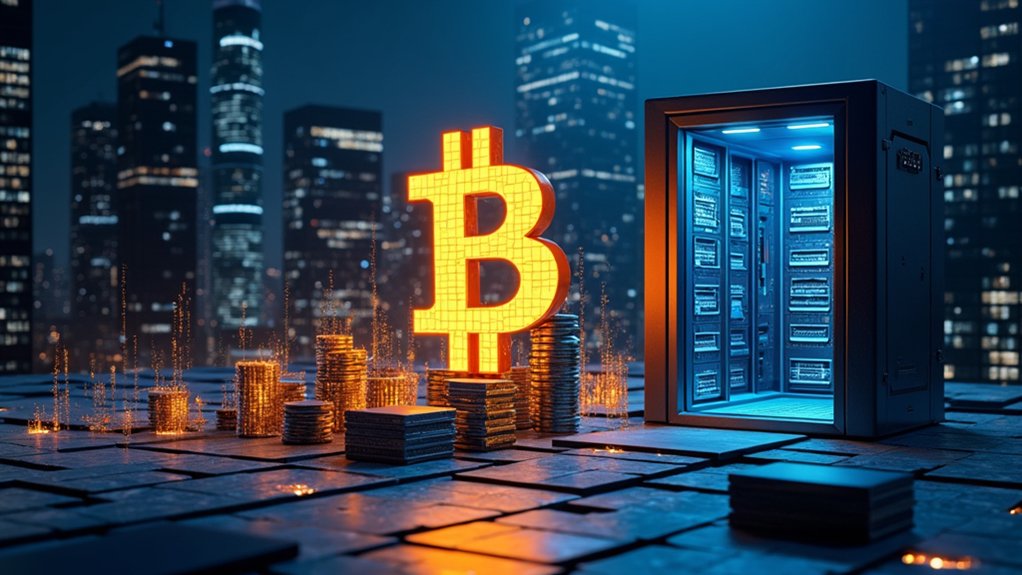The Bitcoin Lightning Network is a newer technology that makes Bitcoin transactions faster and cheaper. It works as a second layer on top of Bitcoin's main network, similar to an express lane on a highway. Instead of recording every transaction immediately, it creates payment channels between users where they can send Bitcoin back and forth instantly. The network can handle millions of transactions per second, making Bitcoin more practical for everyday purchases. There's much more to discover about this groundbreaking upgrade.

The Bitcoin Lightning Network is a groundbreaking upgrade to Bitcoin that's making transactions faster and cheaper than ever before. It's a layer-2 payment protocol that works on top of the Bitcoin blockchain, designed to handle a massive number of transactions without overwhelming the main network.
Think of it like opening a tab at a coffee shop. Instead of paying for each drink separately, you can open a payment channel and settle everything at once later. That's how the Lightning Network operates – it creates payment channels between users where they can send Bitcoin back and forth without recording every single transaction on the blockchain. The concept was introduced in 2015 by researchers who aimed to solve Bitcoin's scalability issues. The Lightning Network can now process billions of transactions per second compared to Bitcoin's twelve transactions.
The system uses smart contracts and multi-signature wallets to keep everything secure. When two people want to transact, they create a payment channel that lets them send money instantly. These transactions happen off-chain, which means they're not immediately recorded on the Bitcoin blockchain. Only when the channel closes does the final balance get recorded on-chain.
What's really clever is that you don't need a direct channel with someone to pay them. The Lightning Network can route payments through other users' channels, kind of like a game of connect-the-dots. This means you can pay anyone on the network, even if you've never opened a channel with them directly. The channels are funded through two-of-two multisig addresses to ensure security of funds.
The benefits are impressive. Transactions can happen almost instantly, and the fees are tiny compared to regular Bitcoin transactions. This makes it possible to send really small amounts of Bitcoin – even just a few cents – which wasn't practical before. The network can handle millions of transactions per second, and since most transactions happen off-chain, it also provides better privacy.
However, the Lightning Network isn't perfect. Users need to lock up some Bitcoin in payment channels to use the network, and some worry that large payment hubs could lead to centralization. The technology can be complicated for average users to understand and use, and there's always the possibility of security issues as the network continues to develop.
Despite these challenges, the Lightning Network represents a significant step forward in making Bitcoin more useful for everyday transactions. It's still being developed and tested, but it's already enabling new uses for Bitcoin that weren't possible before, like paying for small items or streaming tiny payments in real-time.
The network continues to grow as more people discover its benefits for fast, cheap Bitcoin transactions.
Frequently Asked Questions
Can I Use Lightning Network Without Running My Own Bitcoin Node?
Yes, it's possible to use the Lightning Network without running a personal Bitcoin node.
Users can access Lightning through custodial wallets like Zebedee or crypto exchanges that offer Lightning support. This approach is easier and doesn't require technical knowledge or hardware investment.
However, it comes with trade-offs – users have less privacy and control since they're relying on third-party services to handle their transactions.
What Happens to My Funds if My Lightning Network Channel Partner Disappears?
If a Lightning Network channel partner disappears, users can still recover their funds through a non-cooperative channel closure.
They'll need their channel state backup to prove their current balance. The closure process puts the transaction on the main Bitcoin blockchain.
There's usually a 24-hour waiting period before funds are released.
Watchtowers can help by monitoring for any fraudulent closure attempts during this time.
How Much Does It Cost to Open a Lightning Network Channel?
Opening a Lightning Network channel typically costs around 0.4% of the transferred amount as a service fee.
There's also a Bitcoin network fee that varies based on network activity. For example, if someone opens a channel with 100,000 satoshis, they'll pay about 400 satoshis for the service fee plus the network fee.
The total cost can change depending on network conditions and whether additional inbound liquidity is needed.
Are Lightning Network Transactions Traceable Like Regular Bitcoin Transactions?
Lightning Network transactions aren't as traceable as regular Bitcoin transactions.
While normal Bitcoin transactions are visible to everyone on the blockchain, Lightning transactions happen in private payment channels.
Only channel openings and closings show up on the main blockchain.
The network uses onion routing, similar to Tor, which hides payment paths through multiple nodes.
Each node can only see who sent them the payment and where to send it next.
Can I Send Lightning Payments to Someone Who Doesn't Use Lightning?
No, Lightning payments can't be sent directly to someone who doesn't use Lightning Network.
It's like trying to send a text message to someone who doesn't have a phone.
However, there are services called "bridges" or "swap providers" that can convert Lightning payments into regular Bitcoin transactions.
These services work as middlemen, making it possible to send funds to non-Lightning users, though they typically charge a small fee.





